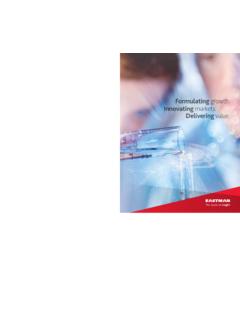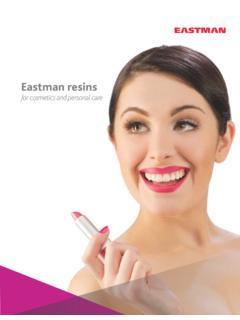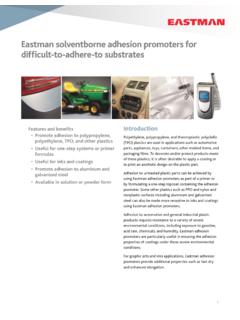Transcription of Tips for thermoforming - eastman.com
1 Tips for thermoformingEastar copolyester 6763 Eastman Tritan copolyester MP100 Eastman Eastalite copolyester MP007 FExtruded sheet Mold designEastar 6763, Tritan MP100, and Eastalite MP007F can be used successfully with male molds, but female molds are recommended. Thermoformed parts made with female molds will have more consistent flange thicknesses, easier part removal, and reduced bridging ( , webbing) issues. Generous draft angles of 5 7 degrees in a tapered mold design will better facilitate part release. All contours should have a minimum radius of 5/64 in. ( mm) throughout the mold design to reduce tray fracture issues. To achieve acceptable finished part detail, vacuum channels should lead directly from the vacuum mold inlet to the vacuum holes on the corners of the mold.
2 Vacuum channels should always be kept clean. Minimize the use of right angles in the vacuum system and piping to maximize vacuum speed. This will enable good contact between the plastic and the mold. To prevent excess bridging and flange thinning, use proper cavity spacing, especially on male molds. For every 1 in. (25 mm) of depth into the mold cavity, there should be 1 in. of space between cavities. Note: Mold shrinkage will vary depending on the thermoforming process equipment. Typical shrinkage percentages are shown in Table process Eastman recommends starting with quality Eastar 6763, Tritan MP100, and Eastalite MP007F sheet. Quality sheet is characterized as having consistent gauge, little to no contamination, low cosmetic defects, and good inherent viscosity ( , molecular weight).
3 Coatings or internal additives are often used to separate packages within a stack ( , denesting). These coatings are not typically used or needed to aid in denesting of Eastalite articles. Silicone-coated sheet is often used to optimize denesting of packages. Eastman suggests using Dow Corning 365 Dimethicone NF Emulsion. When silicone coating is not permitted, an internal antiblock or denest concentrate can be added to the Eastar, Tritan, or Eastalite copolyester resin during extrusion. o These are typically blended with the Eastar resin at a ratio of 50:1 to 100:1. Eastar additives cannot be used in products made of Tritan, and Tritan additives cannot be used in products made of Eastar. o With Tritan, the antiblock and denest concentrates must be specifically formulated for Tritan.
4 These are typically blended with Eastar at a ratio of at least 50:1 but more preferably 20:1 to 10:1. The mold surface should maintain a consistent temperature of 100 F (40 C) to 140 F (60 C) to prevent chill line formation or sticking. Heat settings on thermoforming equipment should be adjusted to produce the highest possible sheet temperature without sticking or bridging. For Eastar 6763, the optimum sheet temperature range for thermoforming is 300 F (149 C) to 350 F (177 C). For Tritan MP100, the optimum sheet temperature range for thermoforming is 350 F (177 C) to 370 F (189 C). For Eastalite MP007F, the optimum sheet temperature range for thermoforming is 230 F (110 C) to 285 F (140 C).Higher sheet temperatures during thermoforming promote lower internal stress in the final packages.
5 However, overheating film and sheet can cause the sheet to sag, resulting in bridging (webbing) in the final thermoformed package. Sheet extruded from Eastar copolyester 6763, Eastman Tritan copolyester MP100, and Eastman Eastalite copolyester MP007F is easy to thermoform. This brochure lists some helpful tips in processing Eastar, Tritan, and 1 Typical mold shrinkageProductTypical mold shrinkage, %Eastar copolyester Tritan copolyester Eastalite copolyester As sheet temperatures increase, the plastic starts to sag which will eventually cause bridging. Sag is the result of temperature and time in the oven. Higher sheet temperatures without additional sag can be obtained by: Decreasing cycle time and increasing oven temperature Heating the sheet without using the full oven length and increasing temperature on the area closest to the mold.
6 Note: Chain rails must be parallel for this setup. Two-sided heating may be required. For blank-fed male mold thermoforming machines, forming can be improved and bridging can be eliminated by using wire-helper grids. Internal stresses should be monitored using a polarized light sheetSharp, properly guarded, and well-maintained steel cutters are required for proper trimming of formed packages. A typical trimming press uses steel-rule or matched metal die design Double bevel measuring 3 point, in. ( mm) with a Rockwell C hardness of 45 to 55 is suggested. Blisters should be cut through completely when using steel-rule cutting. The cutting stroke on the trim press should stop ( , fixed stroke) just after cutting through the blister.
7 This is known as a kiss cut. Stainless steel striker plates in. ( mm) thick with an equivalent (or slightly softer) hardness than the die material are recommended. Heated steel-rule knives can often improve the quality of the cut. Dies should have steel backup plates with a thickness of in. ( mm). Backup plates should be made of metal with a Rockwell C hardness of 30 to 35. Matched metal punches and dies should be properly maintained and have as close to zero tolerance as possible. Eastman recommends following these tips to fully experience the benefits of easy thermoforming with Eastar copolyester 6763, Eastman Tritan copolyester MP100, and Eastman Eastalite copolyester MP007F on a consistent 2 copolyester thermoforming conditionsProductForming range (sheet temp)Optimum forming rangeEastar copolyester 6763225 F (107 C) 350 F (176 C)300 F (148 C) 350 F (176 C)Eastman Tritan copolyester MP100300 F (148 C) 380 F (193 C)350 F (176 C) 370 F (187 C)Eastman Eastalite copolyester MP007F200 F (93 C) 290 F (143 C)230 F (110 C) 285 F (140 C)
8 SP-MBS-1604A 7/16 Safety Data Sheets providing safety precautions that should be observed when handling and storing Eastman products are available online or by request. You should obtain and review the available material safety information before handling any of these products. If any materials mentioned are not Eastman products, appropriate industrial hygiene and other safety precautions recommended by their manufacturers should be is the responsibility of the medical device manufacturer ( Manufacturer ) to determine the suitability of all component parts and raw materials, including any Eastman product, used in its final product to ensure safety and compliance with requirements of the United States Food and Drug Administration (FDA) or other international regulatory agencies.
9 Eastman products have not been designed for nor are they promoted for end uses that would be categorized either by the United States FDA or by the International Standards Organization (ISO) as implant devices. Eastman products are not intended for use in the following applications: (1) in any bodily implant applications for greater than 30 days, based on FDA-Modified ISO-10993, Part 1, Biological Evaluation of Medical Devices tests (including any cosmetic, reconstructive, or reproductive implant applications); (2) in any cardiac prosthetic device application, regardless of the length of time involved, including, without limitation, pacemaker leads and devices, artificial hearts, heart valves, intra-aortic balloons and control systems, and ventricular bypass assisted devices; or (3) as any critical component in any medical device that supports or sustains human life.
10 For manufacturers of medical devices, biological evaluation of medical devices is performed to determine the potential toxicity resulting from contact of the component materials of the device with the body. The ranges of tests under FDA- Modified ISO-10993, Part 1, Biological Evaluation of Medical Devices include cytotoxicity, sensitization, irritation or intracutaneous reactivity, systemic toxicity (acute), subchronic toxicity (subacute), implantation, and hemocompatibility. For Eastman products offered for the medical market, limited testing information is available on request. The Manufacturer of the medical device is responsible for the biological evaluation of the finished medical suitability of an Eastman product in a given end-use environment is dependent on various conditions including, without limitation, chemical compatibility, temperature, part design, sterilization method, residual stresses, and external loads.









